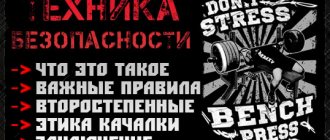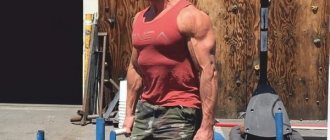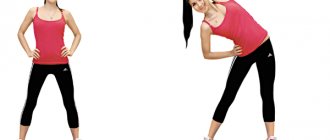Share:
What you need
- Barbell
- Platform
The Clean and Jerk is one of the classic weightlifting exercises that has migrated into functional CrossFit training.
Due to the technical complexity of the exercise, as a rule, the barbell push is included in the training program by more experienced and trained athletes, however, many beginners also try to perform the push (unfortunately, often incorrectly) in their training. In our article today, we will share with you a technique for learning how to properly perform a barbell push and help you minimize the risk of injury.
What's on our plan today:
- Why should you perform the barbell jerk?
- Exercise technique
- Mistakes of beginner athletes
- Official sports standards
- How to achieve an increase in strength indicators at the point?
- Crossfit complexes with barbell push.
Why is this exercise needed?
As a child, even before I became seriously interested in sports, I loved watching weightlifting competitions. This is truly a great sport, and many athletes, such as Yuri Petrovich Vlasov, Leonid Ivanovich Zhabotinsky, Vasily Ivanovich Alekseev and others, have left a truly enormous sports legacy, and their phenomenal results continue to motivate athletes from all over the world even after decades.
Weightlifters perform the clean and jerk as part of a competition, and their main goal is to lift the heaviest weight. In CrossFit, we have slightly different goals, performing the clean and jerk primarily to increase tonnage and overall intensity of the workout.
I don’t know about you, but for me, complexes that contain a barbell push are the most difficult due to the decent working weights and the need to strictly follow the correct technique. If you look at the total tonnage per workout, it's a huge number. But after completing all the complexes, no matter how difficult they may be, a feeling of satisfaction comes, because I realize that I worked 100%.
During the barbell push, the following muscles work: quadriceps, glutes, spinal extensors and deltoids. Therefore, I recommend wisely distributing the load throughout the week, for example, not performing heavy weightlifting exercises in one workout and heavy deadlifts and front squats in another. Thus, your muscles simply will not have time to recover, overtraining will occur, which will lead to a complete lack of progress in training, constant muscle pain, chronic fatigue, sleep disturbances and exhaustion of the central nervous system.
History and facts
Equipment resembling weights was made in Ancient Greece and was used for training by Olympians.
But with the advent of the Dark Ages, the cult of a healthy body disappeared and there was no mention of this projectile for a long time. In modern times, weights were used only as measures of weight in trade.
By the 19th century, they began to be used again to develop the body, but there was no talk of serious sport: kettlebells were mainly used by circus performers who entertained the public.
Only towards the end of the same century, exercises with kettlebells received official recognition, began to be actively included in athletes’ training programs and were a type of weightlifting.
And in the middle of the last century, kettlebell lifting became an independent discipline. Thus, in the USSR in 1948, the first All-Union Strongman Competition was held.
Although the rules of this competition were regulated rather vaguely, it was significant, because it significantly popularized kettlebell lifting and gave it light both as a professional discipline and as an amateur means of physical education.
The modern rules of kettlebell lifting were finally formed by the early 90s.
The world record holder in the one-arm kettlebell snatch weighing 16 kg is Sergei Trifanov. In one hour he did 1501 repetitions.
Technique for performing the barbell push
Due to the technical complexity of the exercise, I recommend seeking help from a competent specialist. Below I will try to describe in as much detail as possible the correct technique for performing a push, but only with an outside glance can you soberly evaluate the technique, point out mistakes and help the student achieve the desired result.
The standing barbell jerk is a technically difficult exercise, and professional weightlifters spend years honing the technique. The barbell push involves a huge range of motion, and the movement itself consists of several stages: lifting the barbell off the floor, lifting, squatting, pushing out and scissoring squat. Each stage should be worked out separately in order to fully understand the biomechanics of movement. Under no circumstances should you rush if you are not given a particular stage. Start practicing them with minimal weights until the trainer is happy with your technique. After this, you can begin to perform the clean and jerk, again, starting with light weights.
The barbell comes off the floor
Starting position:
- Feet shoulder width apart;
- Hands hold the bar slightly wider than shoulder-width apart with a lock grip;
- The toes are spread slightly to the sides, the center of gravity lies on the heels;
- We keep our back perfectly straight, while maintaining natural lordosis in the lower back;
- We move our shoulders slightly back, looking forward.
Our task is to use the powerful force of the legs and back to lift the barbell from the floor and give it the necessary acceleration in order to throw it onto the chest. Raise the barbell just above the knee, while the bar should be as close to the shin as possible.
Detonation
In order to accelerate the barbell and throw it onto your chest, you need to straighten your legs and body, stand on your toes (a small jump is allowed), bend your arms and “accept” it with your chest, while at the same time starting to lower yourself into a squat. In this case, your elbows should be brought out in front of you.
Podsed
When the barbell is at the level of the solar plexus, we begin to squat under it, while moving it with the movement of our shoulders towards our chest. If everything is done correctly, approximately halfway through the squat, the bar should “fall” onto your chest. We sit with her on our chest in full amplitude, stand up and fixate ourselves. We have a couple of seconds to gather our strength and prepare to push out. During the push of the barbell, keep your elbows turned away from each other so that the barbell lies not on your chest, but on your shoulders.
Pushing + scissor squat
With an explosive movement of the legs and buttocks, we begin to push the barbell up, while performing a scissor squat. Some weightlifters perform a split squat, but due to the anatomical characteristics of most people, the scissor squat is easier for them and allows them to lift more weight. We make a small jump, bringing one leg forward and the other back. The movement is reminiscent of lunges with a barbell. As soon as we have caught the balance point, we put the back foot to the front and fixate in this position. Now you can throw the barbell on the floor.
Detailed training on the barbell push technique in the video:
Another useful video:
Endurance development
There are two types of endurance, each of which can be developed by kettlebell lifting. The first type is strength endurance. To lift something heavy, a person needs developed strength. But in order to move a heavy object, it is strength endurance that is required. It is quite simple to develop this indicator by doing a kettlebell jerk. The muscles involved in this exercise will develop not only in terms of strength, but also in terms of endurance. In addition, as strength indicators increase, a person’s overall endurance will also increase. For this reason, kettlebell lifting is recommended for runners and swimmers.
It is worth noting that you can develop strength endurance or general endurance without giving up your chosen sport. The kettlebell snatch or swing exercise can be done on a free day from training. Twice a week will be enough to develop strength and endurance.
Typical beginner mistakes
- Pushing the barbell is carried out primarily due to the force of the quadriceps and buttocks, while the deltoids and triceps are responsible for stabilizing the projectile. Do not confuse the clean and jerk with a push press or a military press, here we are not pumping our shoulders, we are breaking the laws of physics.
- You should not perform snatches and jerks in regular sneakers or sneakers. Spend a few thousand rubles and buy specialized high-quality weight bars; they will help keep your body in the correct position during squats. At one time, I added 40 kg to my squats with a barbell in two workouts, simply by switching from sneakers to barbells. Progress in the clean and jerk was also not long in coming.
- Contact a smart trainer. On your own, you are unlikely to be able to establish the correct push technique; only with an outside glance can you make adjustments to the technique, based on the individual anatomical characteristics of the body.
- Pay special attention to warming up your hands and elbows. When the barbell is placed on the chest and the elbows are brought forward, the joints and ligaments experience enormous stress. Use statodynamic exercises to further strengthen your ligaments and tendons.
Data
- An impressive result in the standing press belongs to the Russian athlete Peter Krylov. He pressed a 32kg kettlebell a whopping 86 times. It is believed that competitive athletes should train with this type of kettlebell;
- The kettlebell press was one of the exercises of competitive kettlebell lifting, but then it was excluded from the program due to lack of entertainment and too complex criteria for evaluating the technique;
- Kettlebell lifting guru in the West, Pavel Tsatsouline, believes that the standing kettlebell press is much more useful than the bench press of barbells and dumbbells. It engages both the upper chest and triceps, as well as the deltoids and promotes harmonious muscle development. In addition, the situation when you need to pick up something and put it on a shelf occurs much more often than when you need to do push-ups from the floor, for example, so standing kettlebell press helps prevent household injuries. This is especially useful due to the fact that we press while standing first with one hand, then with the other, and we also lift things most often with one hand;
- Adequate weights are selected depending on strength and body weight. Most people should start not with a third of their body weight, as sources recommend, but with a quarter or one-eighth. Fitness sources recommend that girls start training with a 4kg kettlebell and guys start with an 8kg kettlebell. Then progress accordingly to 8 and 16 and further, as the sports result increases.
Standards
Next, we have prepared for you the official standards for the barbell push for the year, approved by the Russian FTA.
Table of standards for men (sum: clean and jerk + snatch, kg):
| Weight category | Combined total (kg) | ||||||||
| Adults | Boys 11-15 years old | ||||||||
| MSMK | MS | KMS | 1 | 2 | 3 | 1 yun | 2 yun | 3 yun | |
| 34 kg | – | – | 90 | 82 | 76 | 70 | 64 | 58 | 52 |
| 38 kg | – | – | 105 | 96 | 88 | 80 | 72 | 64 | 56 |
| 42 kg | – | – | 120 | 110 | 100 | 90 | 80 | 70 | 60 |
| 46 kg | – | – | 130 | 119 | 108 | 97 | 86 | 75 | 64 |
| 50 kg | – | 180 | 150 | 137 | 124 | 110 | 96 | 82 | 68 |
| 56 kg | 255 | 205 | 170 | 154 | 138 | 122 | 106 | 90 | 74 |
| 62 kg | 285 | 230 | 190 | 170 | 152 | 134 | 116 | 98 | 80 |
| 69 kg | 315 | 255 | 205 | 185 | 165 | 145 | 125 | 106 | 87 |
| 77 kg | 350 | 280 | 235 | 210 | 187 | 164 | 141 | 118 | 95 |
| 85 kg | 365 | 295 | 250 | 225 | 200 | 175 | 151 | 127 | 103 |
| 94 kg | 385 | 310 | 260 | 235 | 210 | 185 | 162 | 137 | 112 |
| +94 kg | – | 315 | 265 | 240 | 215 | 190 | 167 | 142 | 117 |
| 105 kg | 400 | 320 | 270 | 245 | 220 | 195 | – | – | – |
| +105 kg | 415 | 325 | 275 | 250 | 225 | 200 | – | – | – |
Table of standards for women (sum: clean and jerk + snatch, kg):
| Weight category | Combined total (kg) | ||||||||
| Adults | Girls 11-15 years old | ||||||||
| MSMK | MS | KMS | 1 | 2 | 3 | 1 yun | 2 yun | 3 yun | |
| 34 kg | – | – | 80 | 72 | 66 | 60 | 54 | 48 | 42 |
| 36 kg | – | – | 85 | 77 | 71 | 65 | 58 | 51 | 44 |
| 40 kg | – | – | 90 | 83 | 76 | 69 | 62 | 55 | 48 |
| 44 kg | – | 120 | 100 | 92 | 84 | 76 | 68 | 60 | 52 |
| 48 kg | 165 | 130 | 105 | 96 | 88 | 80 | 72 | 64 | 56 |
| 53 kg | 180 | 140 | 115 | 106 | 97 | 88 | 79 | 70 | 61 |
| 58 kg | 190 | 150 | 125 | 115 | 105 | 96 | 86 | 76 | 66 |
| 63 kg | 205 | 160 | 135 | 125 | 115 | 104 | 93 | 82 | 71 |
| 69 kg | 215 | 170 | 145 | 135 | 125 | 113 | 101 | 89 | 77 |
| 75 kg | 225 | 180 | 150 | 138 | 127 | 116 | 105 | 94 | 83 |
| +75 kg | – | 185 | 155 | 143 | 132 | 121 | 110 | 99 | 88 |
| 90 kg | 230 | 190 | 160 | 150 | 140 | 130 | – | – | – |
| 90 kg+ | 235 | 195 | 165 | 155 | 145 | 135 | – | – | – |
What is a kettlebell?[edit | edit code]
Kettlebells 8, 12, 16, 24 and 32 kg
| Emblem of the Kettlebell Lifting Federation |
| Weight-lifting |
| Theory |
|
| Inventory |
| Training |
|
| Competitive exercises |
|
| Preparatory exercises |
|
| Nutrition and recovery |
|
Weight
- a sports equipment of a given mass, which has a special shape in the form of a metal core with a handle and other design features.
The word kettlebell first appeared in the Russian dictionary in 1704 (Cherkikh, 1994).
Artistic weights, with faces
Weights by weight
Russian weights are traditionally measured in pounds. One pud is an old Russian unit of measurement equivalent to 16 kilograms (about 35 pounds). The most popular weights in Russia: 1 pound for beginner men; 1.5 pounds, or 53 pounds - the standard weight of an army weight; and the so-called “dvuhpudovka”, 2 poods, or 70 pounds. The two-pudovka is used by experienced weight lifters.
Competitions in kettlebell lifting are held with kettlebells weighing 16, 24 and 32 kg. During training, weights of a more varied gradation are used.
According to the rules of the MSGS, MFGS, VFGS, sports competitive weights must have the following parameters:
| Dimensions | Color |
| height - 280 mm | 16 kg - yellow |
| case diameter - 210mm | 24 kg - green |
| handle diameter - 35 mm | 32 kg - red |
Approximate conversion of poods and kilograms to pounds
| Puds | Kilograms | Pounds | |
| 0,25 | 4 | 9 | |
| 0,375 | 6 | 13 | |
| 0,5 | 8 | 18 | |
| 0,75 | 12 | 26 | |
| 1 | 16 | 35 | For beginners |
| 1,25 | 20 | 44 | |
| 1,5 | 24 | 53 | Popular army option |
| 1,75 | 28 | 62 | |
| 2 | 32 | 70 | For experienced weightlifters |
| 2,5 | 40 | 88 | |
| 3 | 48 | 106 |
Heavy kettlebells are traditionally called "bulldogs"
. “Heavy” is a relative concept; usually weights heavier than 32 kg are included in this category. 48 kg is the maximum weight for a kettlebell, but it did not stop Russian strongmen. Weightlifting legend Yuri Vlasov was upset when someone stole his custom-made 56kg weights.
Dragon Door produces high-quality classic Russian-style rubber-coated cast iron kettlebells ranging from 26 to 106 pounds and women's kettlebells from 9 to 18 pounds.
Kettlebell workouts
Kettlebells provide complete and comprehensive development. Multifunctional strength, power and flexibility. They get rid of fat without necessarily doing aerobics. In just 1-2 hours of training per week. All you need is one compact and literally indestructible projectile that can be used anywhere.
What kind of weights do you need?
Start with one weight, the table will help you choose the right weight. If funds allow, buy a set of three or four weights presented in the table.
| Start with the right kettlebell | ||
| Who are you? | Kettlebell to start (kg) | Ideal set (kg) |
| Average girl | 8 | 8, 12, 16 |
| Strong girl | 12 | 12, 16, 20 |
| Average man | 16 | 16, 20, 24, 32 |
| Strong enough man | 20 | 20, 24, 32 |
| Very strong man | 24 | 24, 32, 40 |
Do you need two kettlebells of the same weight? Not yet. There are great double kettlebell exercises, watch senior kettlebell trainer Mike Mahler do them, but they're not for beginners. Start with one kettlebell, work on strength imbalances, and train the snatch and press.
The average person should start with a 16kg kettlebell. What does "average" mean? If the bench press is used as a standard test to evaluate strength (which is incorrect), then a man lying on a bench pressing a barbell weighing 90 kg should start with 16 kg. If you bench more than 90 kg, then try training with a 20 kg kettlebell. If you are a powerlifter or strongman, start with 24 kg.
A woman with average physical fitness should start with 8 kg. A strong woman can try 12 kg. Most women should aim for 16kg. Few stubborn women will go further. Katherine "Catherine of Steel" Imes, a master kettlebell lifter, can bench press a 32kg kettlebell five times, putting many men to shame.
You've probably noticed that the weight of kettlebells, unlike dumbbells, increases in larger increments. There is simply no need for additional hardware. Inventive weightlifters don't need a ton of weights to progress their workouts. You save money and space.
How to progress on the clean and jerk?
The secret to a powerful push is practicing individual phases of the movement and performing auxiliary exercises.
Do the following exercises:
- push push of the barbell to separately practice pushing the barbell above you;
- overhead squats and front squats to strengthen the squat;
- heavy lunges with a barbell on your shoulders to make it easier to get up from scissors;
- push with pause - this exercise involves holding a 1-3 second half squat or full squat before completing the exercise;
- deadlifts from plates, hyperextensions with additional weights and your favorite exercises for the abs and oblique muscles of the abdomen to more clearly hold the body while rising from a squat and not get injured in the lumbar spine.
Recipes for healthy eating
Lenten vegetable okroshka
- 1.9 g Protein
- 1.8 g Fat
- 6.5 g Carbohydrates
- 48.2 kcal
30-40 min.
- #vegetarian dish
- #mustard
- #dietary
- #for vegans
- #green onions
- #potato
- #low calorie
- #dinner
- #vegetables
- #vegetable dish
- #cucumber
- #first course
- #radish
- #dinner
- #dill
Other recipes
Examples of jerk training[edit | edit code]
Source: “Cross-training”
Author:
instructor O.B. Derval, 2016
Workout 1 - “towards infinity”
Perform 1 push, then 1 squat and 1 roll while standing on your knees, add 2 repetitions of each of the last two exercises for each approach, that is:
- 1 clean and jerk / 3 squats / 3 kneeling rolls
- 1 clean and jerk / 5 squats / 5 barbell rolls on your knees, etc.
There is no time limit, you need to complete as many repetitions as possible.
Stopping within a series also stops the repeat counter.
Workout 2 - Technical Development
- squats 4 x 5
- push 4x3
- half-thigh lift 4 x 3
- 3 x sequence: barbell lift / squat / snatch, with a minute start for 7 minutes
Workout 3 - NITRO
- 3 barbell cleans - 6 jumping jacks - 30 meters sprint. 15 sets, 2 minutes recovery between sets.
Exercise space and equipment
The greatest advantage that weights can give is the ability to exercise at any convenient time, as well as in any convenient place. If regular bodybuilding requires a lot of space and a lot of equipment, then for the sport in question you only need weights. In order to perform exercises such as kettlebell snatches, it is recommended that beginners purchase 16 kg equipment.
Over time, the athlete's strength and endurance will increase, and to perform the exercise it will be necessary to change the equipment to heavier ones. First, the weights change from 16 kg to 24 kg, and then from 24 kg to 32 kg.
You can purchase such equipment at a sports store. If you want to save money, you can buy weights from friends or secondhand (for example, through advertisements). In this case, the price will be much lower. There is no difference between the shells, since their appearance and characteristics have remained unchanged for decades.
Crossfit complex
The double kettlebell snatch is a popular exercise often used in CrossFit. The following is a complex that is suitable for an athlete with a high level of physical fitness. If you are at an intermediate level, you can reduce the number of repetitions in each exercise.
Only 1 round at a time, do not change exercises.
- Mach 53
- 200 m of penetration with two weights on outstretched arms;
- 53 sumo row to the chin;
- 150m penetration with two weights on outstretched arms;
- 53 Snatch of two weights;
- 100m penetration with two weights;
- 53 Kettlebell Extensions;
- 50m penetration with weights.
The average execution time for athletes is 30-45 minutes, depending on preparation.
Breath
Among other things, kettlebell lifting involves precise training of breathing techniques.
If you do not pay attention to this, the body will not receive enough oxygen for intensive work, which will certainly affect the results. The muscles will quickly get tired, and the desired benefits of training will turn out to be harmful.
If you breathe incorrectly, your muscles quickly tire. Strength sports involve exhaling when performing an effort and inhaling during the muscle relaxation phase.
During a jerk, breathing can be done in 2, 3 cycles or more. The best option is 3 cyclic breathing:
- Inhale - lift the weight from the floor.
- Exhalation is the end of the explosion.
- Inhale - sit down.
- Exhale - straighten the body and arms.
- Inhale - lower the weight from the top point to chest level.
- Exhale - lowering the projectile until it goes into the swing.
Having mastered the kettlebell snatch, you can move on to practicing a more complex element - the jerk. You should also start with 16 kg. Or, if you just love kettlebell lifting, and participating in competitions or receiving a GTO badge is not part of your plans, you can limit yourself to simpler exercises.
Exercise 6 Raising dumbbells with both hands from the ground to the shoulder
Place a dumbbell next to the outside of each leg, body upright, heels together, toes apart at a comfortable angle, head tilted down, body ready to grip the dumbbells. Keeping your back straight, bending your body at the hips and bending your legs at the knees, bend down and grab the dumbbells, as in photo No. 31. Now with a quick movement, pull the dumbbells straight to the sides of your chest, towards your armpits, elbows bent outward, the movement is aided by strong pressure from both legs; then step back with both knees slightly bent, swing the dumbbells upward with a quick jerk, with your forearms underneath them and your elbows resting on your hip joints. The whole movement is fast, the legs bear the main tension.
You can lift the dumbbells from your shoulder either with a jerk or a slow press. The jerk movement is almost the same as a one-arm lift: almost easier, since two weights keep the body in balance. For a slow press raise, the weight of the body must be transferred to the back leg, which can be pulled further back to give an increased point of support as the dumbbells are raised and maintain body balance. When the movement is halfway through, press the dumbbells hard and place your upper body under the dumbbells, this will make the dumbbells easier to lift and will be a good exercise for the spine.
Kettlebell lifting - benefit or harm
The experience of athletes and the statements of doctors prove that working with weights not only helps to pump up muscles, but also develops strength, endurance and good coordination of movements, but it is secretly believed that this is the most traumatic form. What are the benefits of kettlebell lifting?
- helps to lose excess weight;
- is one of the safest;
- very simple exercises;
- minimum costs.
Harm from exercising with weights cannot be ruled out either, but only if the athletes begin immediately by lifting heavy weights. Then the unpleasant consequences can be:
- Crick;
- fractures of fingers or hands;
- heart problems.
Kettlebell lifting - advantages
In order for the benefits of such activities to be greater than the harm, you need to be careful and listen to the trainer’s instructions regarding the load. If you follow all the recommendations, kettlebell lifting has obvious benefits for the body, many athletes agree with this
The list of advantages of such activities is obvious:
- You can study both in a group and individually;
- no need to look for special equipment or sites;
- a personal training method is selected for each person;
- You can start training at any age.
Kettlebell lifting - cons
Since kettlebell lifting requires good physical preparation, you should consult your doctor before enrolling in the section. There are a number of diseases in which you will have to stop exercising. Kettlebell lifting takes into account the following contraindications:
- heart or vascular diseases;
- arrhythmia, tachycardia, hypertension;
- diseases of the gastrointestinal tract;
- lung problems;
- poor vision, astigmatism;
- weak ligaments and brittle bones;
- problems with the endocrine or genitourinary system;
- varicose veins or hemorrhoids.










